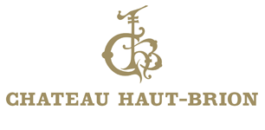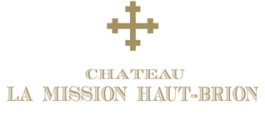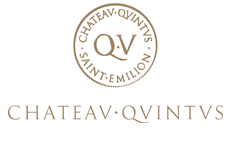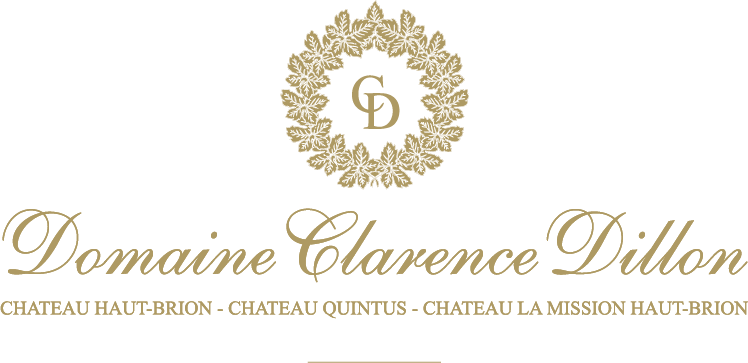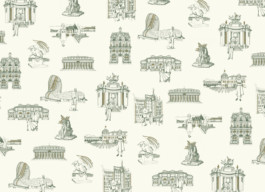
Paris, 1901, a young man walks down a dusty street on the Left Bank, his senses overwhelmed by the exceptional beauty that surrounds him. The streets are extremely busy with horses, carriages, and the very occasional automobile.
Clarence Dillon marvels at the extraordinary new Orsay train station that had been completed only a year earlier for the Exposition Universelle of 1900, in the City of Lights.
This Exposition had been an exceptional exploit for this nation as the world was entering into a new modern era. France and Paris had succeeded in astonishing the world by constructing an ephemeral magical cultural city in only 3 years! 51 million visitors came to discover and marvel at the extraordinary architectural and technological feats personified by the beautiful entrance gate of the exhibition, a perfect metaphor for the old world entering a new era of innovation and possibility. Beyond celebrating the cultures of 40 participating nations, the French put the focus on electricity, transport (the first moving sidewalks/escalators, the trolley bus, the Metro /subway), dry cell batteries, electric cars, talking films, the first magnetic audio recorders etc. Over that summer, the city had also hosted the Olympic games of 1900 and thereby these games were able to benefit from this exceptional new infrastructure provided.
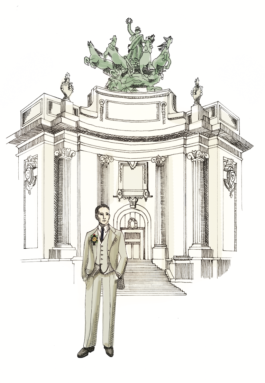
Clarence Dillon in front of the Clarence Dillon Rotunda at Le Grand Palais in Paris

Clarence was a young American student. A first-generation immigrant through his father. The young man enjoyed some French ancestry on both the paternal and maternal sides of his family. His mother spoke perfect French and throughout his education would have brought her son’s attention to the incredible cultural exploits of this nation and of course its friendship with the young United States (only 106 years old at the time of his birth).
Clarence had just graduated from Worcester Academy, a boys boarding school in Massachusetts and had now been offered a place to study at Harvard University, in Boston. In the interim, what better place to come and discover the world than a city that had recently feted the finest sporting and cultural exploits of man. What a platform to launch this young man, filled with curiosity into a world of exceptional prior exploits and endless possibility. Clarence had signed up for cooking classes at the relatively newly minted Le Cordon Bleu school and some printmaking art classes as a backdrop to his Parisian foray. Today he was headed towards “Le Grand Palais des Beaux Arts”. This magnificent glass covered structure was the largest of its kind in Europe. In an era when electricity was only just being ushered in, the natural light of such a glass structure was still key in order to illuminate the extraordinary creative beauty of the exhibits that it would come to house.
Crossing the newly built, Pont Alexandre III, Clarence was able to cast his gaze up and down the shimmering beauty of the Seine River, while taking in the exceptional historic monuments that had come to grace her banks over the centuries. Eventually, his eyes came to rest on the gargantuan new crystal palace, Le Grand Palais, that now lay between him and the most famous avenue in the world, Les Champs Elysees. The young man could just make out the corner entrance that gave out onto the river. While having celebrated the arts for the prior year, Le Grand Palais was now bringing its focus to motor vehicles, with its first ever Salon de L’Automobile. The country had fewer than 10,000 cars on its national territory and roads in this year, but as it was the case for young Clarence, the world was going to change…and at a very rapid pace. One can only imagine how stimulating these months must have been for the young man as he was continuing his journey of discovery that had started in the small town of San Antonio, Texas, back in 1882. It was an exhilarating time in the City of Lights. This was the exact year that his contemporary, Pablo Picasso moved here and that that 19-year-old held his first important exhibit focused on what was going to be known as his Blue period.
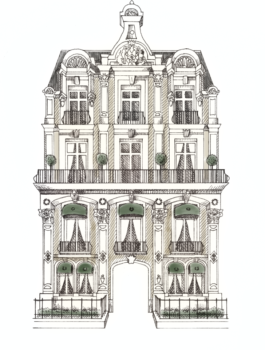
The Dillon private mansion at 31 Avenue Franklin D. Roosevelt,
home to the fine dining restaurant Le Clarence and La Cave du Château
It is hardly surprising then, that given this timely introduction to the city, that Paris would eventually become the future European headquarters of Clarence Dillon’s Investment Bank, Dillon Read, and that his future young family would eventually come and spend summers in nearby Normandy before Clarence eventually would decide to acquire a Chateau in Bordeaux (Château Haut-Brion), in 1935. The investment bank no longer exists today, but his estate in Bordeaux has grown into a small group of companies, today named Domaine Clarence Dillon. The seat of this company is now located on Avenue Franklin Delano Roosevelt, just behind Le Grand Palais.
Beyond this legacy, what has also survived through generations of his kin is this young man’s passion for France and his desire to celebrate the very finest in human culture.
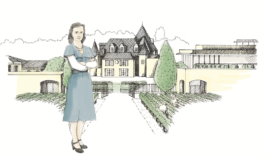
Dorothy Dillon at Château Haut-Brion
Clarence’s passion for culture and the arts in fact, profoundly influenced his family. His daughter, Dorothy, sometimes spent parts of her summers at Château Haut-Brion, where she hosted artists and intellectuals.
She served on the boards of numerous cultural and educational institutions in the United States, advancing the family’s tradition of patronage. My grandfather, her brother, C. Douglas Dillon, served as U.S. Ambassador to France in 1953, following in the footsteps of figures like Benjamin Franklin and Thomas Jefferson. A lover of the arts, after years of public service work and his time in government, he eventually became President of the Metropolitan Museum of Art in New York, championing the creation of its Asian Wing.
This passion he shared with his wife, my grandmother, Phyllis Dillon, a trustee of the Museum of Modern Art (MoMA). Together, they built significant art collections, predominantly French, which they eventually donated to their favourite museums. In 1953, their daughter (my mother, Joan Dillon) became one of the founding members of the famed literary journal, The Paris Review. Over three generations, five members of the Dillon family received the Légion d’Honneur for their services to France—a testament to their deep connection with the country.
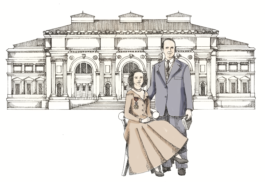
C. Douglas Dillon and his wife, Phyllis Dillon,
in front of the Metropolitan Museum of Art in New York
The example set by Clarence Dillon, along with the guidance of our grandparents and parents, has provided us with a clear roadmap, inspiring us to build upon some truly remarkable legacies.
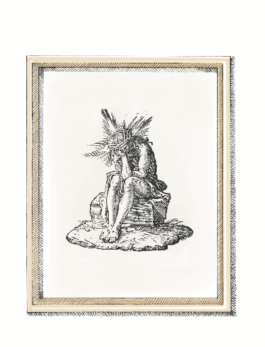
The wood engraving La Petite Passion by Albrecht Dürer,
part of the collections at La Mission Haut-Brion
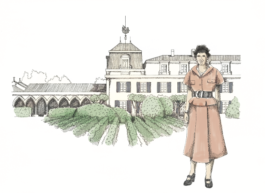
Joan Dillon, Duchess of Mouchy,
at La Mission Haut-Brion
Within our family company, we have curated exceptional collections of objects, art, and a remarkable library that will take center stage with the unveiling of our new installations at Château Haut-Brion, in 2026.
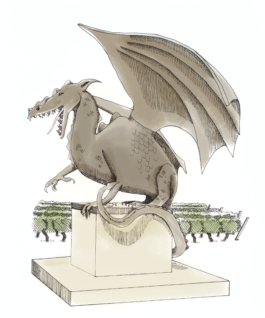
The Quintus Dragon
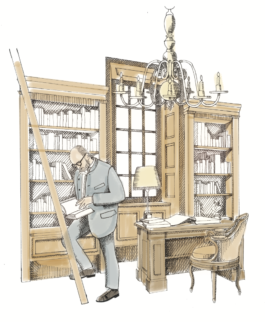
Prince Robert of Luxembourg
in the vast library of Château Haut-Brion
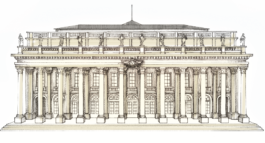
Le Grand Théâtre of Bordeaux
We are deeply honoured to have had the opportunity to support numerous French institutions, including the Cité du Vin in Bordeaux, Le Grand Théâtre in Bordeaux, the Louvre, and, most recently, Le Grand Palais. Beyond these partnerships, we have also actively collaborated with a variety of cultural institutions on a global scale, reflecting our enduring commitment to celebrating and preserving the arts and culture worldwide. Clarence, perhaps shaped by his early experiences, grew into a true citizen of the world. Like Franklin or Jefferson, he embodied the spirit of a Renaissance man. He returned to Europe frequently, traveling every summer except during the wartime years, driven by a desire to see, understand, and engage with the continent on multiple levels.
His profound curiosity, coupled with his keen observational skills and a talent for truly listening, cultivated invaluable friendships, connections, and insights that enriched both his personal and professional life. Clarence’s deep affection for France inspired him to support the nation in times of need through humanitarian aid and to champion cultural endeavours that elevated the human spirit in happier times.
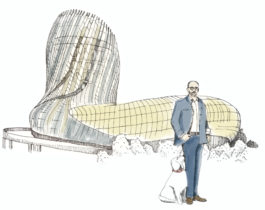
Prince Robert of Luxembourg
in front of La Cité du Vin in Bordeaux
Listening and eventually hearing are rare talents in a busy world. The Arts and fine wine can offer us moments of respite from the noise. Have you ever noticed that moment of pause and ecstasy of the senses when the mind is truly silenced by exceptional beauty? A perhaps fleeting but marked pause. An extraordinary piece of music, a landscape, a baby’s smile…. or even a sip of exceptional wine. The mind goes silent….it knows that it is in the presence of the divine. We are moved by these moments. Ideally, we share these moments with others’ and that they remind us of something beyond ourselves something greater that unites us all as humans.
Clarence would have been deeply moved—and perhaps a little awed—as he approached the vast new edifice of Le Grand Palais in 1901. At that moment, the young student could never have imagined that 125 years later, his family company would be honoured to be able to contribute to the renovation of this iconic building, which continues to stand as a beacon of human culture and creativity. In a touching tribute, the entrance facing the bridge he once crossed now bears his name: La Rotonde Clarence Dillon. While this eponymous honour recognizes Clarence’s enduring affection for France, it also serves as a broader celebration—a testament to the timeless gift of discovery and beauty. It symbolizes the inspiration that such places ignite in young people across generations, much like Clarence himself experienced in 1901. More than just a tribute to one man, this portal into one of the world’s greatest cultural landmarks is a salute to the shared human journey of learning, creativity, and wonder.
May this holiday season bless you and your loved ones with moments of shared joy and wonder!
Robert de Luxembourg

Visit our websites and follow us
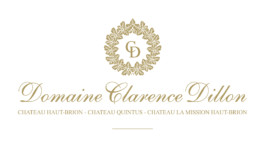

Paris, 1901, a young man walks down a dusty street on the Left Bank, his senses overwhelmed by the exceptional beauty that surrounds him. The streets are extremely busy with horses, carriages, and the very occasional automobile.
Clarence Dillon marvels at the extraordinary new Orsay train station that had been completed only a year earlier for the Exposition Universelle of 1900, in the City of Lights.
This Exposition had been an exceptional exploit for this nation as the world was entering into a new modern era. France and Paris had succeeded in astonishing the world by constructing an ephemeral magical cultural city in only 3 years! 51 million visitors came to discover and marvel at the extraordinary architectural and technological feats personified by the beautiful entrance gate of the exhibition, a perfect metaphor for the old world entering a new era of innovation and possibility. Beyond celebrating the cultures of 40 participating nations, the French put the focus on electricity, transport (the first moving sidewalks/escalators, the trolley bus, the Metro /subway), dry cell batteries, electric cars, talking films, the first magnetic audio recorders etc. Over that summer, the city had also hosted the Olympic games of 1900 and thereby these games were able to benefit from this exceptional new infrastructure provided.

Clarence Dillon in front of the Clarence Dillon Rotunda at Le Grand Palais in Paris

Clarence was a young American student. A first-generation immigrant through his father. The young man enjoyed some French ancestry on both the paternal and maternal sides of his family. His mother spoke perfect French and throughout his education would have brought her son’s attention to the incredible cultural exploits of this nation and of course its friendship with the young United States (only 106 years old at the time of his birth).
Clarence had just graduated from Worcester Academy, a boys boarding school in Massachusetts and had now been offered a place to study at Harvard University, in Boston. In the interim, what better place to come and discover the world than a city that had recently feted the finest sporting and cultural exploits of man. What a platform to launch this young man, filled with curiosity into a world of exceptional prior exploits and endless possibility. Clarence had signed up for cooking classes at the relatively newly minted Le Cordon Bleu school and some printmaking art classes as a backdrop to his Parisian foray. Today he was headed towards “Le Grand Palais des Beaux Arts”. This magnificent glass covered structure was the largest of its kind in Europe. In an era when electricity was only just being ushered in, the natural light of such a glass structure was still key in order to illuminate the extraordinary creative beauty of the exhibits that it would come to house.
Crossing the newly built, Pont Alexandre III, Clarence was able to cast his gaze up and down the shimmering beauty of the Seine River, while taking in the exceptional historic monuments that had come to grace her banks over the centuries. Eventually, his eyes came to rest on the gargantuan new crystal palace, Le Grand Palais, that now lay between him and the most famous avenue in the world, Les Champs Elysees. The young man could just make out the corner entrance that gave out onto the river. While having celebrated the arts for the prior year, Le Grand Palais was now bringing its focus to motor vehicles, with its first ever Salon de L’Automobile. The country had fewer than 10,000 cars on its national territory and roads in this year, but as it was the case for young Clarence, the world was going to change…and at a very rapid pace. One can only imagine how stimulating these months must have been for the young man as he was continuing his journey of discovery that had started in the small town of San Antonio, Texas, back in 1882. It was an exhilarating time in the City of Lights. This was the exact year that his contemporary, Pablo Picasso moved here and that that 19-year-old held his first important exhibit focused on what was going to be known as his Blue period.

The Dillon private mansion at 31 Avenue Franklin D. Roosevelt,
home to the fine dining restaurant Le Clarence and La Cave du Château
It is hardly surprising then, that given this timely introduction to the city, that Paris would eventually become the future European headquarters of Clarence Dillon’s Investment Bank, Dillon Read, and that his future young family would eventually come and spend summers in nearby Normandy before Clarence eventually would decide to acquire a Chateau in Bordeaux (Château Haut-Brion), in 1935. The investment bank no longer exists today, but his estate in Bordeaux has grown into a small group of companies, today named Domaine Clarence Dillon. The seat of this company is now located on Avenue Franklin Delano Roosevelt, just behind Le Grand Palais.
Beyond this legacy, what has also survived through generations of his kin is this young man’s passion for France and his desire to celebrate the very finest in human culture.

Dorothy Dillon at Château Haut-Brion
Clarence’s passion for culture and the arts in fact, profoundly influenced his family. His daughter, Dorothy, sometimes spent parts of her summers at Château Haut-Brion, where she hosted artists and intellectuals.
She served on the boards of numerous cultural and educational institutions in the United States, advancing the family’s tradition of patronage. My grandfather, her brother, C. Douglas Dillon, served as U.S. Ambassador to France in 1953, following in the footsteps of figures like Benjamin Franklin and Thomas Jefferson. A lover of the arts, after years of public service work and his time in government, he eventually became President of the Metropolitan Museum of Art in New York, championing the creation of its Asian Wing.
This passion he shared with his wife, my grandmother, Phyllis Dillon, a trustee of the Museum of Modern Art (MoMA). Together, they built significant art collections, predominantly French, which they eventually donated to their favourite museums. In 1953, their daughter (my mother, Joan Dillon) became one of the founding members of the famed literary journal, The Paris Review. Over three generations, five members of the Dillon family received the Légion d’Honneur for their services to France—a testament to their deep connection with the country.

C. Douglas Dillon and his wife, Phyllis Dillon,
in front of the Metropolitan Museum of Art in New York
The example set by Clarence Dillon, along with the guidance of our grandparents and parents, has provided us with a clear roadmap, inspiring us to build upon some truly remarkable legacies.

The wood engraving La Petite Passion by Albrecht Dürer,
part of the collections at La Mission Haut-Brion

Joan Dillon, Duchess of Mouchy,
at La Mission Haut-Brion
Within our family company, we have curated exceptional collections of objects, art, and a remarkable library that will take center stage with the unveiling of our new installations at Château Haut-Brion, in 2026.

The Quintus Dragon

Prince Robert of Luxembourg
in the vast library of Château Haut-Brion

Le Grand Théâtre of Bordeaux
We are deeply honoured to have had the opportunity to support numerous French institutions, including the Cité du Vin in Bordeaux, Le Grand Théâtre in Bordeaux, the Louvre, and, most recently, Le Grand Palais. Beyond these partnerships, we have also actively collaborated with a variety of cultural institutions on a global scale, reflecting our enduring commitment to celebrating and preserving the arts and culture worldwide. Clarence, perhaps shaped by his early experiences, grew into a true citizen of the world. Like Franklin or Jefferson, he embodied the spirit of a Renaissance man. He returned to Europe frequently, traveling every summer except during the wartime years, driven by a desire to see, understand, and engage with the continent on multiple levels.
His profound curiosity, coupled with his keen observational skills and a talent for truly listening, cultivated invaluable friendships, connections, and insights that enriched both his personal and professional life. Clarence’s deep affection for France inspired him to support the nation in times of need through humanitarian aid and to champion cultural endeavours that elevated the human spirit in happier times.

Prince Robert of Luxembourg
in front of La Cité du Vin in Bordeaux
Listening and eventually hearing are rare talents in a busy world. The Arts and fine wine can offer us moments of respite from the noise. Have you ever noticed that moment of pause and ecstasy of the senses when the mind is truly silenced by exceptional beauty? A perhaps fleeting but marked pause. An extraordinary piece of music, a landscape, a baby’s smile…. or even a sip of exceptional wine. The mind goes silent….it knows that it is in the presence of the divine. We are moved by these moments. Ideally, we share these moments with others’ and that they remind us of something beyond ourselves something greater that unites us all as humans.
Clarence would have been deeply moved—and perhaps a little awed—as he approached the vast new edifice of Le Grand Palais in 1901. At that moment, the young student could never have imagined that 125 years later, his family company would be honoured to be able to contribute to the renovation of this iconic building, which continues to stand as a beacon of human culture and creativity. In a touching tribute, the entrance facing the bridge he once crossed now bears his name: La Rotonde Clarence Dillon. While this eponymous honour recognizes Clarence’s enduring affection for France, it also serves as a broader celebration—a testament to the timeless gift of discovery and beauty. It symbolizes the inspiration that such places ignite in young people across generations, much like Clarence himself experienced in 1901. More than just a tribute to one man, this portal into one of the world’s greatest cultural landmarks is a salute to the shared human journey of learning, creativity, and wonder.
May this holiday season bless you and your loved ones with moments of shared joy and wonder!
Robert de Luxembourg

Visit our websites and follow us
